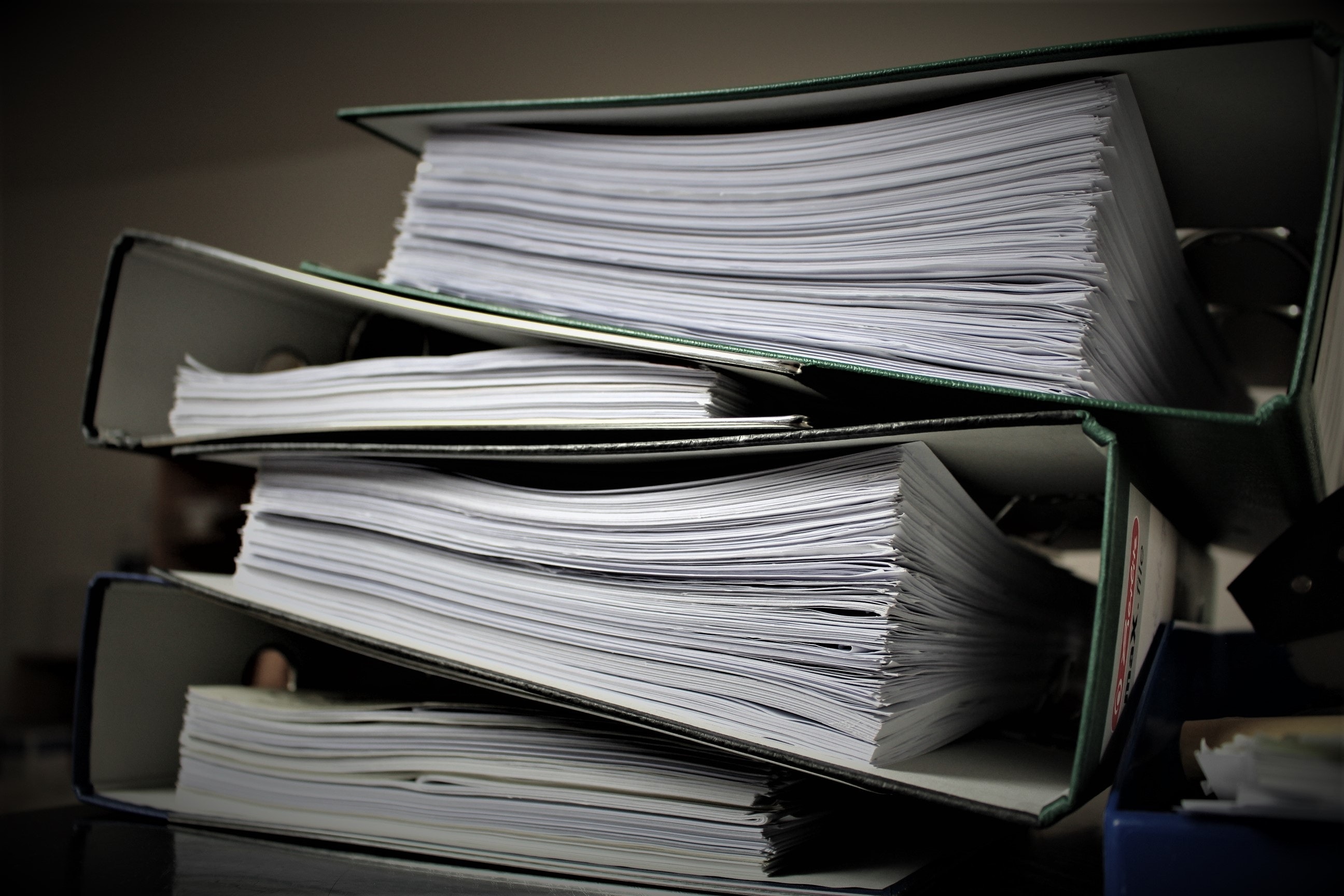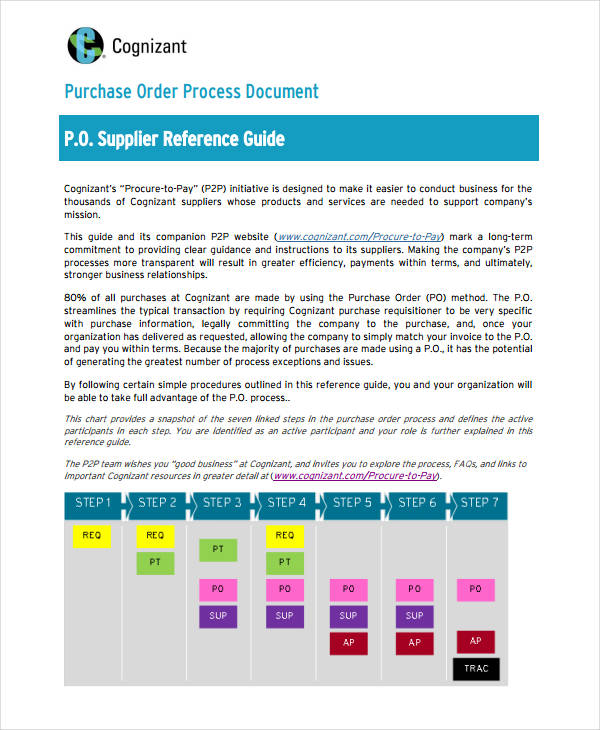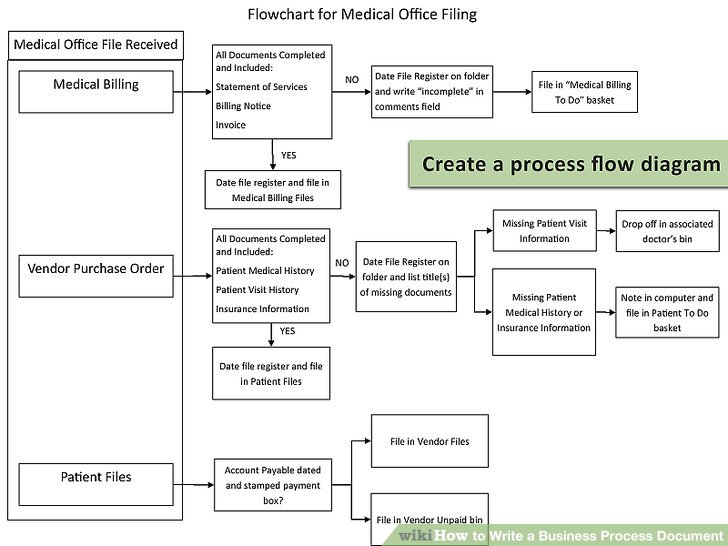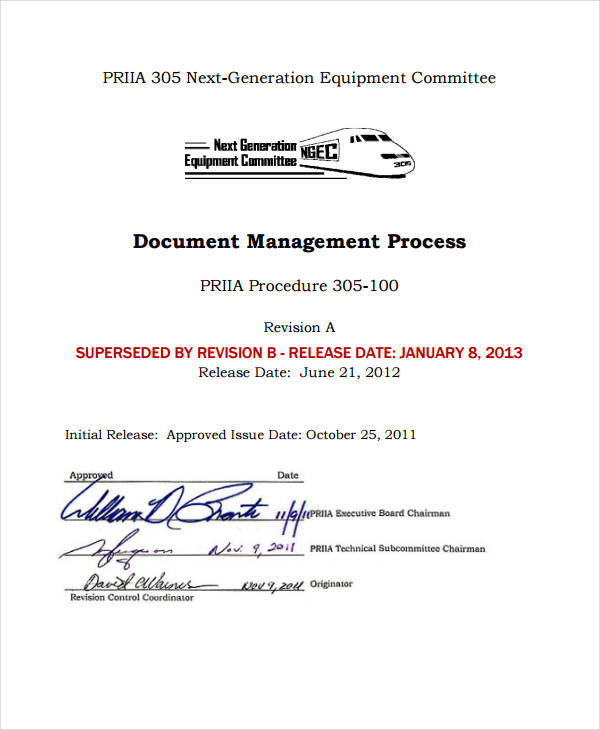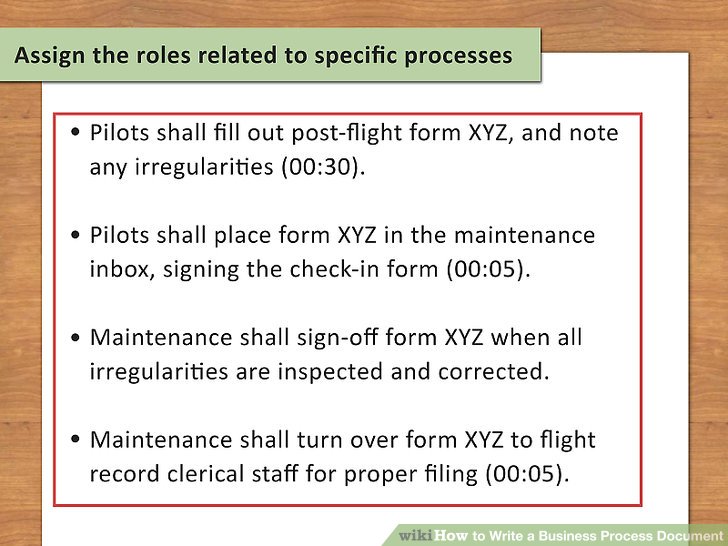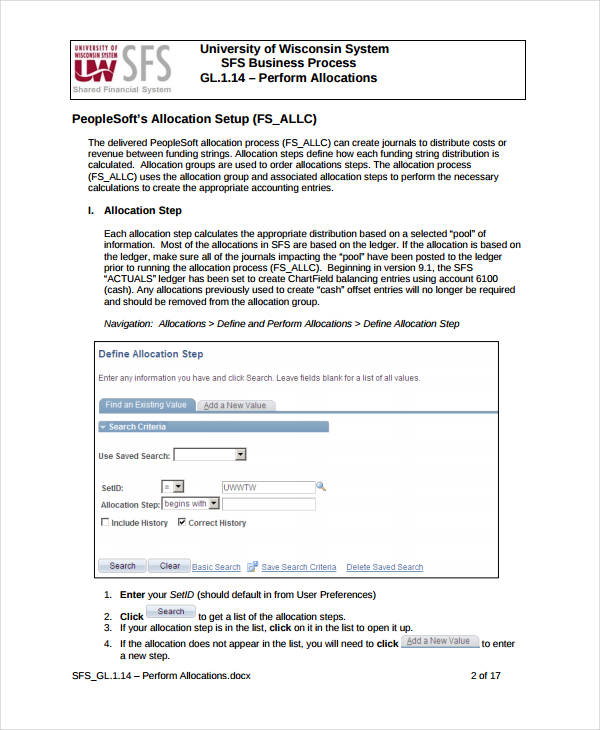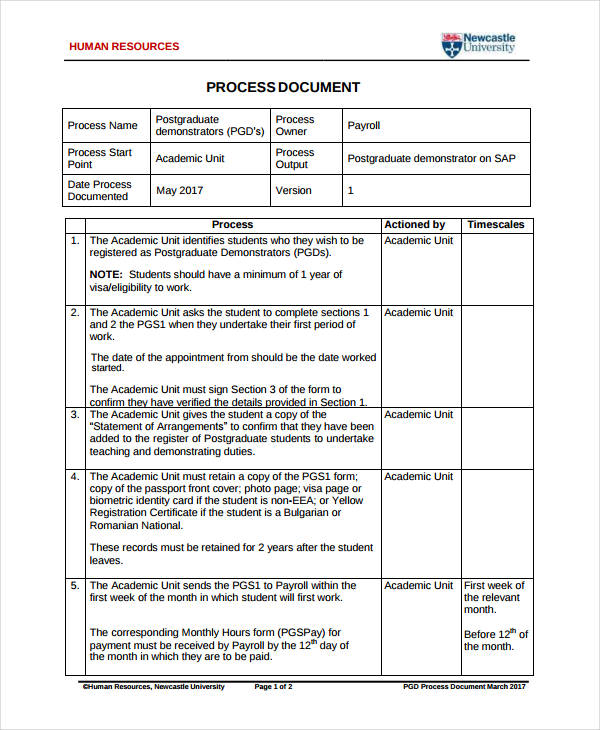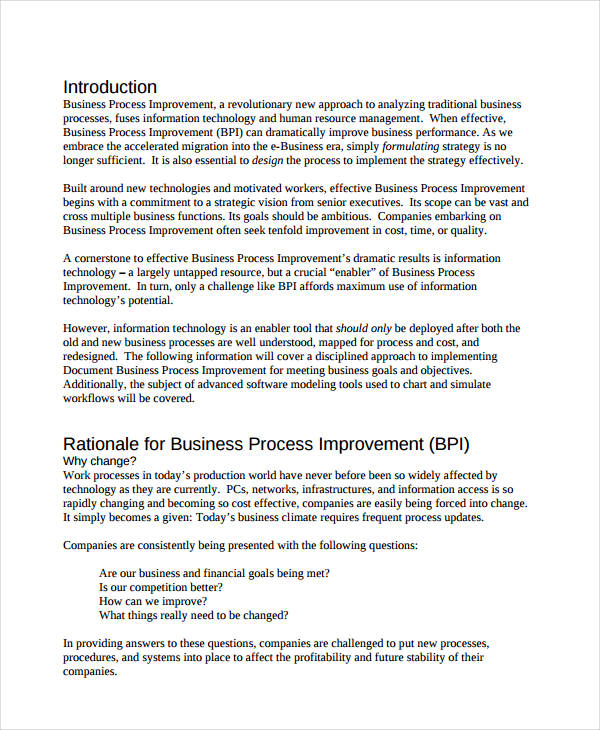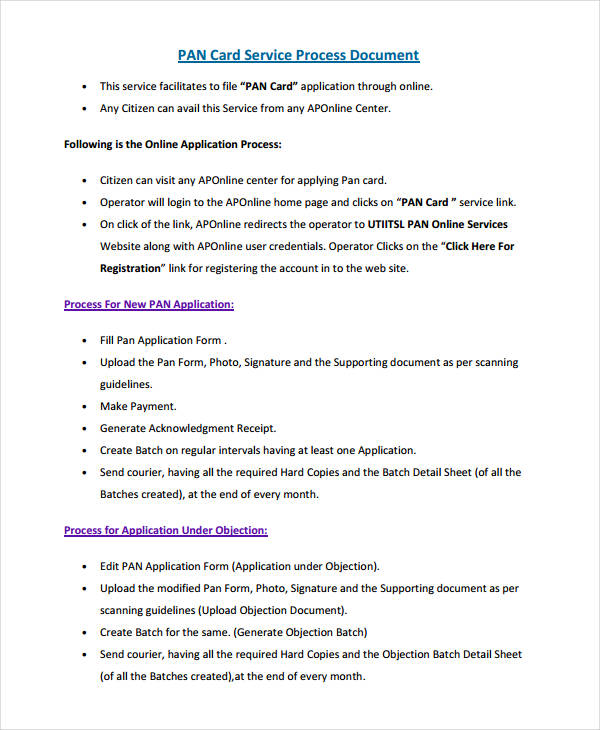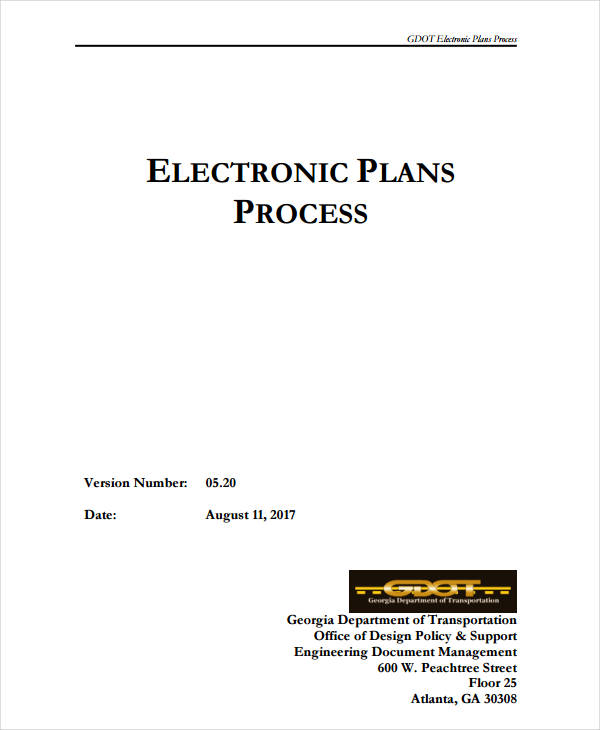10+ Process Document Examples to Download
Every time an article is written by someone using a computer, there is a good chance that such article was written using a computer program, in most cases, Microsoft Word. But there are many other writing programs out there such as LibreOffice Writer, Scribus, FocusWriter, Evernote, et cetera. All these writing softwares make use of document templates for the writer to type in the words. The most common template is a blank template, but other documents can also have pre-designed layouts for specific purposes.
Business Process Improvement Report Template
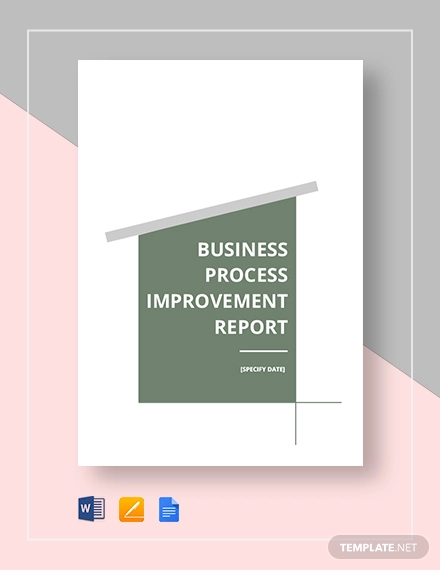
When you also get school or government-related documents, there is also a certain process that you have to follow as well.
For instance, you cannot just claim your documents overnight or on that day as these particular things take time. Can you imagine what would happen if nobody really adhered to policy and legal processes? All hell would eventually break loose and chaos would ensue. And nobody would like that now, would they? Nevertheless, here are some of the ways to even begin listing down processes. You may also like flow chart examples & samples.
Beginning a Process Document
1. Identify the process.
Almost anything these days can be listed into a process. From making pasta to baking cakes to making your own D-I-Y Christmas card to assembling a TV to writing your own simple letter to paying your bills the right and proper way to installing an antivirus software in your laptop. And since anything these days can be listed as a process, it is very important for you to best recall on what people would need to do for this certain situation.
2. Figure out what resources your readers will need.
Next step would be to identify the resources that your readers or viewers might need to do to follow the process in order.
In cookbooks, the ingredients are listed beforehand with the required measurements. But keep in mind though that cooking and baking both involve math. Too much or too little of a certain ingredient can cause the whole thing to collapse or even fall apart as you won’t exactly follow procedure anymore. Understanding the resources involved will come in handy when deciding how to describe each of the steps. Here are some of the necessary resources based on the aforementioned examples provided:
- Making pasta: water, pasta, salt, cooking pot, colander, heat, time
- Baking a cake: sugar, flour, water, butter, vanilla extract, eggs, baking powder, and salt
- Writing a letter: writing and spelling skills, paper, pen or pencil
- Paying the bills: going to the place itself or pay via convenience store or mall, pay via cash or card, and list the form in the form with the required details found
You may also see technical report examples & samples.
3. Consider your audience.
Before moving forward, you would need to consider your audience or specifically, your readers or viewers. Remember that your audience is very ordinary, so please do not minimize the use of jargon in listing down your process—especially in cooking as it is known to have a lot of French terms that would sound confusing to a lot of the readers if it is not properly explained. You may also like sales flow chart examples & samples.
- For example, if you are writing a process document about how to cook pasta for a general audience who may or may not know how to cook, then you will probably want to define terms like “al dente” and describe what is meant by a “rolling boil.”
4. Create a title.
Everything needs a title; from books to poems to foreign literature to movies to thesis works. Almost anything needs a brand name or a title. If you have a little creativity in you, you can even come up with a title that sounds cool that people might get attracted and just buy the book or download the process form for free. You may also check out basic flow chart examples & samples.
If you are coming up with a great name or an Asian cookbook, you can phrase it like this: The Best of Asian Cuisine with Chef Jimmy Wang. Or if it just something simple as claiming your school records, you may also make your title as Claiming Your School Records.
5. Use your introduction to attract your readers.
Like every story ever told, it’s important to have an interesting or cool enough introduction so that it does not sound boring and dull. If you cannot persuade your readers to even read the introduction of the process, how can you expect them to continue on?
For DIY items, vloggers would usually make their intro like this: “So you wanna give something nice to your parents on Valentine’s Day or Christmas Day. But you do not exactly have the money or budget to keep buying things for them. Instead of buying them gifts from a department store, why don’t you make something unique and original that is special not just to them but to you as well? I’m very sure that this is something that your parents will like and treasure very much.” You might be interested in flowchart examples.
3-Step Medical Process Document
System Process Document
Purchase Order Process Document
Describing Your Process
1. Break down the process.
In cookbooks, after the ingredients are listed down, the process is always indicated somewhere at the side of the recipe that gives you the complete details on what you need to do in order to duplicate the result perfectly. Here is an example on how you can make an omelette:
- BEAT eggs, water, salt, and pepper in small bowl until blended.
- HEAT butter in 7 to 10-inch nonstick omelet pan or skillet over medium-high heat until hot. TILT pan to coat bottom. POUR IN egg mixture. Mixture should set immediately at edges.
- GENTLY PUSH cooked portions from edges toward the center with inverted turner so that uncooked eggs can reach the hot pan surface. CONTINUE cooking, tilting pan and gently moving cooked portions as needed.
- When top surface of eggs is thickened and no visible liquid egg remains, PLACE filling on one side of the omelet. FOLD omelet in half with turner. With a quick flip of the wrist, turn pan and INVERT or SLIDE omelet onto plate. SERVE immediately. You may also like control chart examples & samples.
2. Place your steps in order.
Next step would be to place the steps in order so that the audience can keep track of what they are doing is right or wrong. What would be the point of not putting the steps in order in the first place? All it’s going to cause is chaos and disaster ending up creating a completely different product from its original design.
For instance, if you are describing the process of making pasta, then you might want to think twice as to whether about whether it makes more sense to tell readers to get out the pasta before or after the water is heating up. Should the process you are trying to describe is something very complicated, you may need to spend a lot more time in considering the logic of the steps you are about to take. You may also check out event flow chart examples & samples.
Listing the steps down, think about as what needs to happen first then second then so on and so forth. Compare this sequence with your list of steps.
3. Determine if you need to offer any additional information.
Some steps might actually need additional tips to follow or even additional resources to perform the process more efficiently and with more finesse leading it to perfection or something close to it. Here are some tips that might just help you out:
- For example, you might advise your readers to set a timer when adding the pasta to the water. Or, you might advise readers to check a piece of pasta before draining the whole pot.
- Try reading off your steps to a friend to see if there is anything you missed. Do not elaborate on anything you have written, just read off your steps to a friend and ask for suggestions. You might be interested in project flow chart examples & samples.
4. Expand on your steps.
Try to be as detailed and as specific as much as possible. Cause once the information is incomplete, it might lead to something else entirely. But just because you have to get extremely detailed does not mean you have to complicate matters or even the set of instructions that needs to be followed. The simpler the instruction is, the better. But in any case you would need to expand the procedure, make it so. You may also see marketing flow chart examples & samples.
- For example, when you advise readers to get out a pot and fill it with water, you will need to say what type of pot readers should use and how much water readers should add to the pot. You might tell readers to use a large stockpot to cook the pasta and to fill it with 12 cups of water.
5. Provide examples.
Examples are important and essential if you would want the readers to better understand on how to better execute the steps correctly. For video DIY examples, it would not exactly pose a problem as the viewers can automatically pause the instructional video from time to time just in case they might be pacing too fast for them to even catch up on. You may also like research memo examples & samples.
But for written directions, try your best to demonstrate by taking pictures of Step 1, Step 2 from time to time so that they may understand as to what they are doing is right or wrong.
- For example, if you are trying to explain to readers how tightly to hold a drumstick to do a drumroll, then you might use the example of holding a pencil to describe how much pressure is required. Readers will be able to relate to holding a pen or pencil and use that knowledge to help them hold a drumstick the right way. You may also check out formal memo examples & samples.
6. Offer troubleshooting advice.
Mistakes happen from time to time. You have to provide a countermeasure as to when a mistake happens, it can be corrected easily. Because you may never know what can happen when you are doing it. Whether in a video format or in a written format, do your best to include every countermeasure available. You might be interested in strategy memo examples & samples.
- For example, perhaps the reason why many people end up overcooking their pasta is because they forget to set a timer. Or perhaps many people struggle with drumrolls because they are holding their drumsticks too tight.
Medical Process Document
Document Management Process
Pilot Process Document Example
Business Process Document Sample
Finishing the Document
1. Include transitions where needed.
Transitions are words that help to improve the flow of your writing. Transitions can help you clarify when readers are supposed to do things in your process. For example, you might advise your readers to set the timer right BEFORE you add the pasta to the boiling water. Or, you might advise your readers to put on oven mitts AND THEN pour the pasta into the colander in the sink. Some other good transition words to use in a process document include:
- next
- after
- first
- last
- also
2. Simplify your language.
Keep in mind that when writing down the process, you are writing for a large audience who may or may not have any idea as to what you are trying to say. Especially with the new and unfamiliar terminology, your audience may be confused on what that means that they might have to research it just to find out. Understand who you are trying to write for and make the language appropriate like so. You may also see internal memo examples & samples.
3. Test the process.
Whether you are the one doing the process or the one making the said process for your audience, you have to understand that it testing like a prototype product before it heads to the market. Testing the process guarantees as to whether the process might be safe or not. You may also like financial memo examples & samples.
When testing out the said process, you can always try to identify any information that you may have missed or anything that might be unclear to your fellow audience. If you are afraid to test out the process, you can just ask a family member or to try it out.
- Ask someone else to test your process as well. Having someone else test your process can ensure even more accuracy in your process document. Ask a friend or family member to use your steps to complete the process you have described. You may also check out business memo examples & samples.
4. Format your document.
Finally, you have to format your document or your instructional video to the way it seems appropriate.
- Process documents may describe a different step in each paragraph or each step might begin with a number or bullet point.
Process Document Printable
Document Business Process Improvement
PAN Card Service Process Document
Electronic Plans Process Document
Remember that following the steps will always get the results that you need. But if you feel that you can improvise a bit, then why not?


